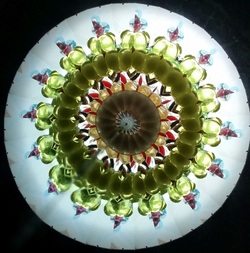Kaleidoscope Triangular Mirror Systems
Most kaleidoscope's you've seen have been based on 3 mirrors arranged in a triangle. You might remember that triangles come in various types: right triangle, equilateral triangle, isosceles triangle, or obtuse triangles. If all 3 sides of an isosceles triangle have mirrors you see what are called full-field images. If only two sides of the triangle have mirrors, with the third being a non-reflective surface, you see a mandala.
When all of the angles of the triangular mirror system evenly divide into 180, the repeating image lines up in a grid pattern. This occurs with equilateral triangles and right triangles. The difference between full-field and grid images (in my nomenclature) is that with full-field images the repeating patterns overlap. With a grid image, the repeating pattern lines up in a grid.
When you look closely at a kaleidoscopic image you will notice the image has a number of points (like a star has 5 points). This is easily seen in mandalas. The number of points you see are based on the tightness of the apex (top) angle. Since an equilateral triangle has the same angle at all 3 corners, you will see a 3 pointed star. As the top angle of the triangle gets tighter (smaller) you end up seeing more points in the star.
I design kaleidoscopes from 3 to 16 points. Click on the images below to see full-field or mandala images in various point configurations.
When all of the angles of the triangular mirror system evenly divide into 180, the repeating image lines up in a grid pattern. This occurs with equilateral triangles and right triangles. The difference between full-field and grid images (in my nomenclature) is that with full-field images the repeating patterns overlap. With a grid image, the repeating pattern lines up in a grid.
When you look closely at a kaleidoscopic image you will notice the image has a number of points (like a star has 5 points). This is easily seen in mandalas. The number of points you see are based on the tightness of the apex (top) angle. Since an equilateral triangle has the same angle at all 3 corners, you will see a 3 pointed star. As the top angle of the triangle gets tighter (smaller) you end up seeing more points in the star.
I design kaleidoscopes from 3 to 16 points. Click on the images below to see full-field or mandala images in various point configurations.

Isosceles Full Field Images
|

|